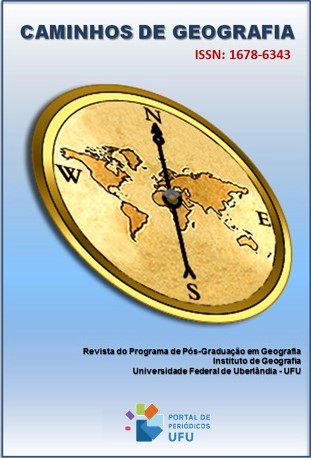ANÁLISE DA DINÂMICA ESPAÇO-TEMPORAL DOS ESPELHOS D’ÁGUA DOS RESERVATÓRIOS DE PERNAMBUCO POR MEIO DE SENSORIAMENTO REMOTO
DOI:
https://doi.org/10.14393/RCG249161719Palavras-chave:
Semiárido, Recursos hídricos, Seca, Google Earth Engine, LandsatResumo
Nos últimos anos, em meio à seca e crise hídrica que afetaram várias regiões do Brasil, em particular a região semiárida, os reservatórios vêm sendo constantemente monitorados. Nesse contexto, o objetivo deste trabalho foi analisar, por meio de Sensoriamento Remoto, a dinâmica dos espelhos d'água dos reservatórios de Pernambuco, a fim de mostrar como a área dos espelhos d'água foi afetada pelas baixas precipitações, compreendendo os anos de 2012 a 2017. Para isso, foi utilizada a plataforma Google Earth Engine para analisar imagens do Landsat. Para a delimitação das águas, foi utilizada uma técnica de realce para converter as imagens RGB para HVS, criando uma imagem pancromática e facilitando o processo de identificação dos espelhos d'água. Desse modo, os resultados indicaram que todos os reservatórios perderam área, onde alguns chegaram a secar completamente. Além disso, os resultados ainda sugerem que os reservatórios localizados nas bacias hidrográficas de clima mais úmido apresentaram menor perda de área em comparação com as de clima mais seco. Essas informações são extremamente importantes para o planejamento e a gestão ambiental dos recursos hídricos, sob a perspectiva de fomentar políticas de abastecimento e, com isso, ampliar a capacidade de enfrentar problemas relacionados à segurança hídrica.
Downloads
Downloads
Publicado
Edição
Seção
Licença
Copyright (c) 2023 Antônio Helton da Silva Barbosa, Miguel Dragomir Zanic Cuellar, Melquisedec Medeiros Moreira, Kátia Alves Arraes, Camila Saiury Pereira Silva

Este trabalho está licenciado sob uma licença Creative Commons Attribution-NonCommercial-NoDerivatives 4.0 International License.
Autores que publicam nesta revista concordam com os seguintes termos: a) Autores mantém os direitos autorais e concedem à revista o direito de primeira publicação, com o trabalho licenciado sob a Creative Commons Atribuição-NãoComercial-SemDerivações 4.0 Internacional. b) Autores têm permissão e são estimulados a publicar e distribuir seu trabalho online (ex.: em repositórios institucionais ou na sua página pessoal), já que isso pode gerar alterações produtivas, bem como aumentar o impacto e a citação do trabalho publicado. c) Em virtude de aparecerem nesta revista de acesso público, os artigos são de uso gratuito, com atribuições próprias, em aplicações educacionais e não-comerciais.











